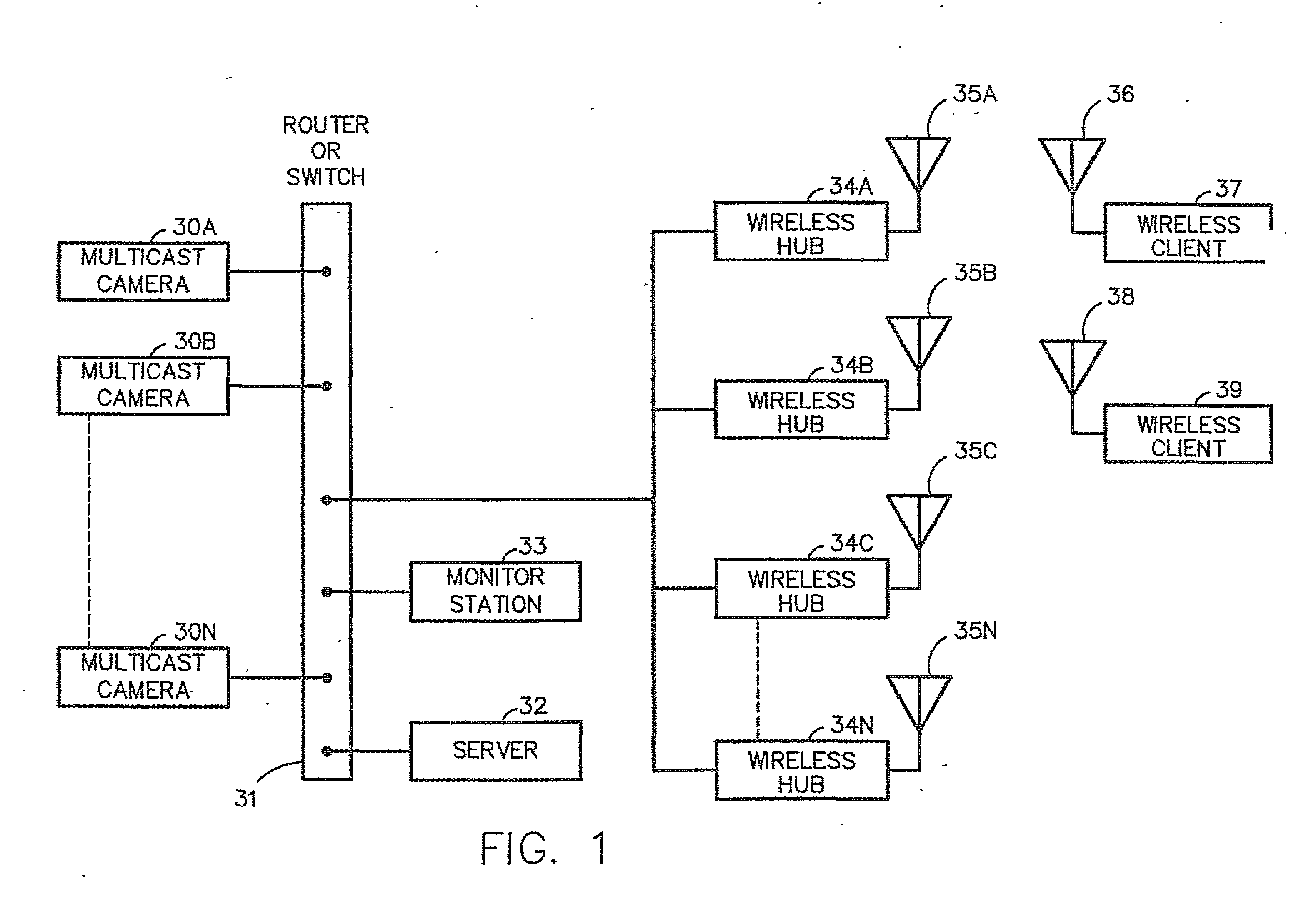Over the past few years, a number of violent incidents including bombings, shootings, arson, and hostage situations have occurred.
The appliances also are not ‘networked’ in the modern sense; they are generally hard-wired to the centralized
monitoring system via a ‘
current loop’ or similar arrangement, and do not provide situational data other than their ON / OFF status.
Video surveillance systems in common use today are particularly dated—they are generally of low quality, using analog signals conveyed over coaxial or, occasionally, twisted-pair cabling to the centralized local monitoring facility.
Further, such systems generally do not have the ability to ‘share’ the captured video, and such video is generally viewable only on the system's control console.
In each case, the video is subject to degradation due to the usual causes—
crosstalk in the wiring
plant, AC
ground noise, interfering carriers, and so on.
Due to the bandwidth constraints imposed by the public-switched telephone system, such systems are typically limited to low-resolution images, or low frame rates, or both.
These cameras use digital techniques for transmission, however their use for security surveillance is limited by
low resolution and by slower refresh rates.
Thus the installation cost and effectivity is limited with the unwieldy restriction of having to have a PC at each camera.
Each of these prior-art systems suffers functional disadvantages.
The low-
bit rate approach can deliver the video
signal to a remote monitoring facility, but only with severely degraded resolution and
frame rate.
While useful, this approach lacks the functional flexibility possible with more modern networking technologies.
The cost of these systems has come down significantly in recent years as the camera and monitor components have steadily dropped in cost while increasing in quality.
There are several limitations to
coaxial cable supported systems.
Second, both the cable, per se, and the installation is expensive.
Both of these limitations limit practical use of coaxial
closed circuit systems to installations requiring less than a few thousand feet of cable.
Third, when the cable cannot be concealed is not only unsightly, but is also subject to tampering and vandalism.
Other hardwired systems have been used, such as
fiber optic cable and the like, but have not been widely accepted primarily due to the higher costs associated with such systems over coaxial cable.
This type of system provides an economical link but does not provide transmission over significant distances due to the power constraints placed on the system.
It is also highly susceptible to interference due to the low power levels and share frequency assignments.
However, the cost is usually much higher per unit, the number of channels is limited and system performance can be greatly affected by building geometry or nearby electrical interference.
Further, the video is not as secure as hardwired systems.
The video may be picked up by anyone having access to the channel while in range of the
transmitter and is thus, easily detected and / or jammed.
While commonly available and relatively low in cost, each of these systems is of
narrow bandwidth and incapable of carrying “raw” video data such as that produced by a
full motion video camera, using rudimentary compression schemes to reduce the amount of data transmitted.
Each of these standards has certain advantages and disadvantages depending upon the volume of data, required resolution and costs targets for the system.
While such devices are useful for their intended purpose, they typically are limited in the amount of data, which may be accumulated and / or transmitted because they do not rely on or have limited compression.
Many of these are personal communications systems do not have the resolution, the
refresh rate required or the security required to provide for good surveillance systems.
However, such products are limited or difficult, if not impossible, to use for security applications because the resolution and
refresh rate (
frame rate) of the compressed motion video is necessarily low because of limited resolution of the original sample and the applications of significant levels of video compression to allow use of the low bandwidth circuits.
The
low resolution of these images will not allow positive identification of persons at any suitable distance from the camera for example.
The
low resolution would not allow the reading of an automobile tag in another example.
As these devices, particularly
digital video cameras and encoders, come in more widespread use within a system, the amount of bandwidth required to transmit continuous, “live” images from an array of cameras is staggering.
This is even a greater problem when
retrofitting current facilities where it is desired to use current wiring or to incorporate wireless networking techniques.
Even where the conduits are of sufficient capacity to
handle the data load, storage and retrieval becomes an enormous task.
As stated, none of the prior art systems readily available accommodates this.
Wide band common carriers such as are used in the broadcast of high quality television signals could be used, but the cost of these long distance
microwave,
fiber or
satellite circuits is prohibitive.
None of the prior art systems permit structured and controlled notification based on the identification of events as they occur.
Even those that do permit some limited notification, for example, alarm systems sending a telephone
signal to a monitoring station, do not provide detailed event information.
 Login to View More
Login to View More  Login to View More
Login to View More 


